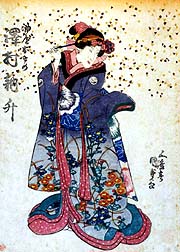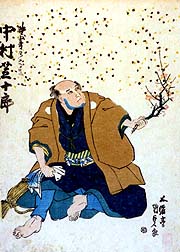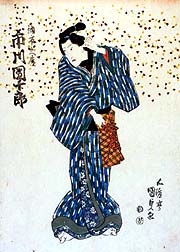| NOZAKI MURA |
| Play title | Shinpan Utazaimon A Newly-Published Ballad |
| Common title | Nozaki-mura |
| Author | Chikamatsu Hanji |
| History |
The play "Shinpan Utazaimon" was originally written for the puppet theater (Bunraku) and staged for the first time in the 9th lunar month of 1780 in ‘saka at the Takemotoza. It was adapted for Kabuki a few years later, in the 5th lunar month of 1785 in ‘saka at the Naka no Shibai [casting]. |
| Structure |
The original story was in 2 volumes. Only one scene survived, the "Nozaki-mura" scene, which ended the first volume. |
| Key words |
Decchi GidayŻ KyŰgen Kago Kagokaki Kari-hanamichi Kawachi Kawarayabashi Mawari-butai Nozaki-mura Osome-hisamatsumono Sewamono Shichiya ShinjŻ ShinjŻmono |
| Summary |
Hisamatsu, employed in the establishment of a well-to-do pawnbroker of ‘saka [1], fell in love with the daughter of the house, Osome. They were apparently made for each other, and the parents of Osome would have gladly given their consent to the marriage, had not the villain of the play, an elderly, dissipated clerk of the pawnshop, cast covetous eyes on his master's daughter, and, jealous of the growing friendliness between Hisamatsu and Osome, spread scandal about them. There is another obstacle, however, for Hisamatsu has already been betrothed to Omitsu. He has been selected by Omitsu's father, according to the prerogative of parents in Japan to choose life companions for their children. Omitsu lives with the old man in the country, anxiously awaiting the day when she will become the bride of Hisamatsu, they having been brought up like sister and brother. One of the best scenes in this long domestic tragedy is the meeting of the three youthful characters. There is something so genuinely homely and human about Omitsu, as she is seen busying herself in preparation for her marriage to Hisamatsu, all unaware that her future husband has already given his heart elsewhere. Those long acquainted with the play know that Omitsu will cut slices from daikon, the long, white, radish-like vegetable, in readiness for the wedding feast, but how she does it is watched with fascination. Every one, too, knows that she will make her toilet before the round metal mirror, full of bashful happiness at the thought of her approaching marriage. Even while Omitsu is deep in thoughts of herself as a bride, her rival, Osome, of whom she has never even dreamed, appears on the hanamichi in the midst of the audience. She is the very acme of good taste and style, the daughter of an ‘saka family that does not lack in this world's goods. She is clad in a resplendent purple kimono. Omitsu can never hope to compete with this beautiful creature, who comes knocking at the cottage entrance. Looking within her mirror Omitsu sees the reflection of the visitor, a vision of beauty, in contrast to her own rustic simplicity, and the flame of jealousy begins to burn. In her confusion she pays no attention to Osome, overturns her mirror, and chops up the daikon recklessly into small pieces. Still hostile to the visitor, who remains waiting for admittance, Omitsu is joined by Hisamatsu and the father, who are not yet aware of a stranger's presence, although Omitsu puts her head out of the door in anything but a hospitable manner, making exclamations of scorn and anger expressive of her hostile state of mind as she pushes her rival away, closes the latticed door, and to make sure that it is secured against Osome's invasion, places against it a bundle of dried twigs gathered for fuel. Very human, too, is the application of moxa, a burning medicine, to the legs of the old farmer, who writhes with pain at each fresh ministration by his daughter. Hisamatsu, taking part in this operation by massaging the old man's shoulders, is surprised to find Osome at the entrance and motions her to go away. He has not yet had time to break the news of his relations to the ‘saka maiden, and is at a loss what to do. Omitsu also continues to show her displeasure, but the unwelcome visitor cannot be driven away. The farmer, at last viewing the newcomer, realises the situation, and drags the unwilling Omitsu out of the room, leaving the lovers together. After a sorrowful love scene between Hisamatsu and Osome, Omitsu returns, but they are astonished to find that she has cut off her hair and wears the garb of a nun. She has decided that Hisamatsu and Osome belong to each other, and so sacrifices herself that they may have no regrets on her account. Osome is full of gratitude, and Hisamatsu is overcome by her sacrifice. Osome's mother next appears to take her daughter home. The stage then revolves [2] showing the side of the cottage, a stream of water, a boat landing, and a boatman waiting for his passengers to the left, while on the right two palanquin men are ready to take Hisamatsu away. Quickly the hanamichi is spread with a blue and white cotton cloth to represent water. Mother and daughter prepare to embark in the boat. The shŰji, or white paper windows of the cottage, are pushed aside, and Omitsu gazes out sadly. To the rippling, merry rhythms of the shamisen, and a spring song in praise of the plum blossom sung in a rollicking way by the palanquin bearers, they take their departure; Hisamatsu carried in a palanquin on one hanamichi looking across the heads of the audience at Osome, and again with regret at Omitsu; Osome and her mother borne over the cotton waves spread out along the main hanamichi, the boatman working so hard at the task of plying the oar that he has to take off his coat to cool himself, the blue and white robed property men really doing all the pushing and pulling of the craft so that it moves smoothly through the audience. Omitsu and the old father stand together outside the cottage, lonely figures, bearing the brunt of the sorrow of farewell. (ZoŽ Kincaid in "Kabuki, the Popular Stage of Japan") |
| Notes |
[1] The Aburaya, a famous shichiya located near the Kawaraya Bridge in ‘saka. [2] The end of the "Nozaki-mura" scene, in which the two lovers go back to ‘saka by separate routes, is very spectacular with the use of the mawari-butai to reveal the back of KyŻsaku's house and the river. Then, Osome and her mother go by boat along the hanamichi (representing the river) while Hisamatsu goes by palanquin along the kari-hanamichi, a secondary (and temporary) hanamichi (representing the bank of the river). |
 |
 |
 |
|
Sawamura TosshŰ I, Nakamura ShibajŻrŰ and Ichikawa DanjŻrŰ VIII playing the roles of Osome, KyŻbÍ and Hisamatsu in the drama "Shinpan Utazaimon", which was staged in the 5th lunar month of 1839 at the Kawarasakiza (print made by Utagawa Kunisada I) |
||
|
|
| Contact | Main | Top | Updates | Actors | Plays | Playwrights | Programs | Links | FAQ | Glossary | Chronology | Illustrations | Prints | Characters | Derivatives | Theaters | Coming soon | News |